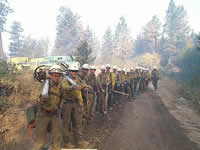
National Fire Plan Overview
National Fire Plan

Though wildland fires play an integral role in many forest and rangeland ecosystems, decades of efforts directed at extinguishing every fire that burned on public lands have disrupted the natural fire regimes that once existed. Moreover, as more and more communities develop and grow in areas that are adjacent to fire-prone lands in what is known as the wildland/urban interface, wildland fires pose increasing threats to people and their property.
The National Fire Plan (NFP) was developed in August 2000, following a landmark wildland fire season, with the intent of actively responding to severe wildland fires and their impacts to communities while ensuring sufficient firefighting capacity for the future. The NFP addresses five key points: Firefighting, Rehabilitation, Hazardous Fuels Reduction, Community Assistance, and Accountability.
The National Fire Plan continues to provide invaluable technical, financial, and resource guidance and support for wildland fire management across the United States. Together, the USDA Forest Service and the Department of the Interior are working to successfully implement the key points outlined in the National Fire Plan by taking the following steps. Select the steps to expand/contract their description, or Contract All | Expand All:
- Assuring that necessary firefighting resources and personnel are available to respond to wildland fires that threaten lives and property
An ongoing priority of the National Fire Plan is ensuring that the agencies of the Departments of Agriculture and Interior maintain a world-class firefighting organization. The Departments will continue to provide all necessary resources to ensure that the fire suppression workforce is at the highest efficiency possible in order to protect life and property in as safe a manner as possible. During the life of the National Fire Plan, major efforts to address the shrinking firefighting workforce have been undertaken, including hiring of additional permanent and seasonal firefighters and permanent fire management staff.
Enhanced training and leadership development opportunities for firefighters and fire managers continue to be delivered through the Wildland Firefighter Apprenticeship Program, the Fire Use Training Academy, and the Prescribed Fire Training Academy. Through these academies, more than 500 people have been trained yearly since the inception of the National Fire Plan.
- Conducting emergency stabilization and rehabilitation activities on landscapes and communities affected by wildland fire
In the aftermath of catastrophic wildland fires, emergency stabilization and post-fire rehabilitation work improves lands that are unlikely to recover naturally from the effects of wildfires. Emergency stabilization treatments are essential to protecting lives and properties downstream of burned areas. This work, often implemented over the course of several years following a wildfire, includes reforestation, road and trail rehabilitation, fence replacement, fish and wildlife habitat restoration, invasive plant treatments, and replanting and reseeding with native or other desirable vegetation.
- Reducing hazardous fuels (dry brush and trees that have accumulated and increase the likelihood of unusually large fires) in the country's forests and rangelands
In response to the risks posed by heavy fuels loads -- the result of decades of fire suppression activities, sustained drought, and increasing insect, disease, and invasive plant infestations -- the National Fire Plan established an intensive, long-term hazardous fuels reduction program. Hazardous fuels reduction treatments are designed to reduce the risks of catastrophic wildland fire to people, communities, and natural resources while restoring forest and rangeland ecosystems to closely match their historical structure, function, diversity, and dynamics. Such treatments accomplish these goals by removing or modifying wildland fuels to reduce the potential for severe wildland fire behavior, lessen the post-fire damage, and limit the spread or proliferation of invasive species and diseases. Treatments are accomplished using prescribed fire, mechanical thinning, herbicides, grazing, or combinations of these and other methods. Treatments are being increasingly focused on the expanding wildland/urban interface areas.
The Healthy Forests Initiative and the Healthy Forests Restoration Act have equipped land managers with additional tools to achieve long-term objectives in reducing hazardous fuels and restoring fire-adapted ecosystems.
- Providing assistance to communities that have been or may be threatened by wildland fire
Communities need many types of assistance, and community participation is at the core of carrying out citizen-driven solutions to reduce the risks of fire in the wildland/urban interface. Agencies provide support for educating citizens on the effects of fire, community fire protection planning, and training and equipping rural and volunteer firefighters. Through a variety of grant programs including Rural, State, and Volunteer Fire Assistance and Economic Action Programs, delivered by the Agencies and the State Foresters, communities can take action to live safely in fire-prone areas.
- Committing to the Wildland Fire Leadership Council, an interagency team created to set and maintain high standards for wildland fire management on public lands
Oversight, coordination, program development, integration, and monitoring are critical to successful implementation of the National Fire Plan. Well-articulated, consistent policies and procedures provide for better oversight and review, and lead to greater accountability. To this end, the Wildland Fire Leadership Council is committed to ensuring the highest level of accountability.